| Century Of
Technology
20 products that prove how Boeing made
into reality what others dared to dream
BY MICHAEL LOMBARDI
BOEING ARCHIVE PHOTOS

A little over 12 years after the Wright Brothers' historic flight at
Kitty Hawk, N.C., William Boeing flew his first airplane. Shortly after,
on July 15, 1916, he incorporated his airplane company.
| Century
of Flight video
To view the video, select your connection speed from the
butons below. In order to view this video you will need the
RealPlayer
plug-in installed in your browser.

|
|
Now, 87 years later, The Boeing Company is still influenced by the pioneering
and enterprising spirit of William Boeing and continues to follow his
philosophy: "We are embarked as pioneers upon a new science and industry
in which our problems are so new and unusual that it behooves no one to
dismiss any novel idea with the statement that 'it can't be done!' ...
Our job is to keep everlastingly at research and experiment ... to let
no new improvement in flying and flying equipment pass us by."
Today the company founded by William Boeing is joined by the companies
founded by other great aviation pioneers: Donald Douglas, James S. McDonnell,
Howard Hughes, James "Dutch" Kindelberger, Frank Piasecki, Lloyd Stearman
and Elrey Jeppesen, who together share a legacy of unrivaled accomplishment
and contribution to the history of flight.
To illustrate the invaluable contribution of our company
to the history of flight, including human spaceflight, members of the Boeing
History Council selected the following 20 products, based on historical significance,
technological innovation and popularity.
Limiting our selection to just 20 products
from a proud and robust pedigree of champions proved to be very difficult,
and there are many others, including rotorcraft and satellites, that
could have been
listed. Nevertheless, these products easily accomplish the task of showing
our legacy of reaching for new frontiers and defining the future of flight.
They
also serve to remind us that our company was built upon the hard work and imagination
of thousands of talented people who dismissed those
who said "it can't be done" and made into reality what others
only dared to dream.
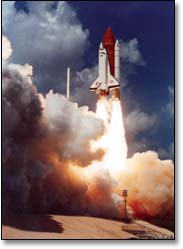 |
Space Shuttle
The Space Shuttle has given NASA a
platform that can routinely accomplish orbital missions including
launching
and repair of satellites and transportation of parts and astronauts
to the International Space Station.
On April 12, 1981, the Columbia
was the first Space Shuttle to fly into orbit and was followed
by four more orbiters: Challenger, Discovery, Endeavor, and Atlantis.
The great success of the shuttle program has come with a high price
as Columbia and Challenger along with each of their crews of seven
astronauts
have been lost—a reminder
of the high risk and courage
involved in spaceflight. |
| |
DWC
In 1924 the Douglas World Cruisers became the first
aircraft to circumnavigate the globe. On April 4 the Chicago,
New Orleans, Boston and Seattle took off from Seattle. On Sept.
28 two
of the planes, the Chicago and New Orleans, returned. They had
logged 27,553 miles in six months and six days, with an actual
flying time
of 371 hours. The flight was the greatest feat in aviation up
to that time. |
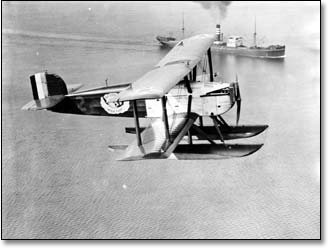 |
| |
|
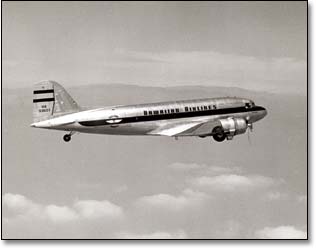 |
DC-2/DC-3/C-47
Introduction of the DC-1 in 1933 marked the beginning of the famous
Douglas Commercial series of aircraft. The success of the DC-2
drove many aircraft into early obsolescence and led to the development
of the legendary DC-3, which made air travel popular and airline
profits possible. Recognized as the greatest airplane of its time,
the DC-3 first took to the air in 1935. By 1939, more than 90 percent
of
the world's airline passengers were flying on DC-2s and DC-3s. During World War
II,
more than 10,000 DC-3s were built as
C-47 military transports. |
| |
|
PT-17 Kaydet and T-6 Texan
Nearly every American
and Allied pilot was trained to fly on these two planes during
World
War II. Most first learned to fly in the PT-13/17 Kaydet trainer,
still
affectionately called "Stearmans." The Kaydet was the primary trainer for the
U.S. Army and Navy, and more than 10,000 were built at the Boeing plant in
Wichita, Kan. Pilots would go on to advanced flight training in the North American
T-6
Texan, known as the SNJ in Navy service and the Harvard in the Commonwealth.
An amazing 14,000 T-6/SNJs were built for the U.S. Navy and Air Force between
1940 and 1945. |
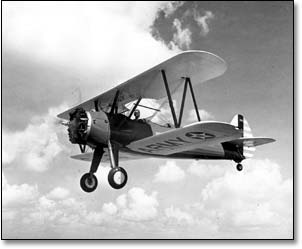 |
| |
|
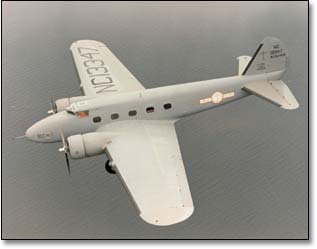 |
Model 247
The world's first modern passenger airliner. In early 1933 it was the first
to combine an all-metal, low-wing, twin-engine design with retractable landing
gear.
It also introduced the autopilot, pneumatically operated de-icing equipment
and the variable-pitch propeller. The 247 flew at 189 mph, nearly 50 mph faster
than
competing airliners. It was able to shave 7 1/2 hours off the flight time from
New York to Los Angeles. |
| |
|
B-17 Flying Fortress
Arguably the most popular plane
of all time and the icon of American airpower during World War
II, the Flying Fortress and the courageous men who flew her were
the
backbone of the Allied air campaign to destroy the German air
force and the war-making ability of Nazi Germany. This paved the
way for
the Allied invasion at Normandy. The B-17 became legendary, and
garnered the everlasting affection of its crews, for being able
to absorb
crippling damage and still fly home. The B-17 made Boeing a household
name and gave the company a reputation for building capable,
rugged, quality airplanes. |
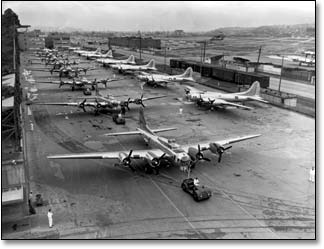 |
| |
|
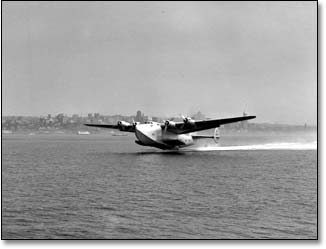 |
314 Clipper
The Clipper was the largest commercial
transport of its time and the icon of the romantic era of flight.
Pan American bought 12 of the Clippers to fly routes across the
Pacific and the Atlantic, where the 314 pioneered the first scheduled
transatlantic
flights. The airplane's 74 passengers were pampered with staterooms,
a lounge and a dining salon, and the Clipper seats could convert
into 40 bunks. The Clipper became the first of a long line of Boeing
presidential airplanes when Franklin Roosevelt flew the Clipper
to the Casablanca conference in 1943. |
| |
|
B-29 Superfortress
Along with the Atomic bomb, the
B-29 was the most technologically advanced program of World War
II. So great was the wartime requirement, the B-29 was pressed
into production
before the prototype had flown. Because of its long range the Superfortress
served exclusively in the Pacific Theater, where after 331 missions
and delivering two atomic weapons the B-29 secured the end of World
War II. After the war the B-29 served as the backbone of the fledgling
Strategic Air
Command. Derivatives of the B-29 include the world's first production aerial
tanker—the KC-97—and the 377 Stratocruiser. |
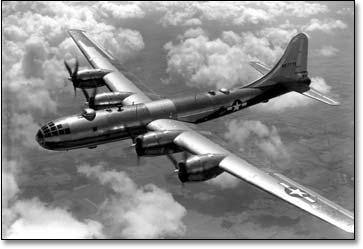 |
| |
|
 |
F-86 Sabre
The first U.S. swept-wing jet fighter,
the F-86 scored consistent victories over Russian-built MiG fighters
during the Korean War, accounting for a final ratio of 10-to-1.
All
39 United Nations jet aces won their laurels in Sabres. The Sabre
first flew on Oct. 1, 1947, and was flown by North American test
pilot George Welch, who flew the F-86 through the sound barrier
just weeks after Chuck Yeager's record-breaking flight. Various
models of the Sabre held world speed records for six consecutive
years.
North
American Aviation built more than 6,000 Sabres. |
| |
|
P-51 Mustang
First to use the laminar flow wing,
the Mustang took just 117 days to go from concept to first flight.
When
married with the Rolls-Royce Merlin engine the Mustang became
a true thoroughbred. It is considered by most to have been the
finest
piston-engine fighter
World War II. The Mustangs' unequaled range allowed them to escort B-17s to any
target deep inside Germany and still have enough fuel to sweep the sky of German
fighters, including the ME-262 jet fighter. One of the highest honors accorded
to the Mustang was its rating in 1944 by the Truman Senate War Investigating
Committee as "the
most aerodynamically perfect
pursuit plane in existence." |
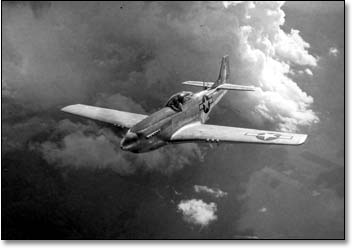 |
| |
|
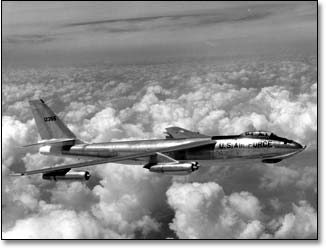 |
B-47 Stratojet
The world's first large swept-wing
jet, the B-47 was a revolution in aviation technology. It incorporated
a plethora of
new concepts that had a direct and lasting impact on future jet
aircraft, both military and commercial. The B-47 pioneered the
basic design
for large jets, incorporating swept wings at 35 degrees and introducing
podded engines. The B-47 design continues to be the basic pattern
for current and future jet transports including the A380 and 7E7.
Lessons learned resulted in spoilers, yaw dampers, maintenance
access and structural integrity. |
| |
|
B-52 Stratofortress
First entering service on June 29, 1955, the B-52 was the premiere
nuclear deterrent during the Cold War. Originally designed to carry
nuclear weapons, the B-52 has been called upon to drop only conventional
weapons. It served with distinction during the Vietnam War, Operation
Desert Storm—where B-52s employed the first use of conventional
air-launched cruise missiles—and most recently in the war against
terrorism in Afghanistan and in Operation Iraqi Freedom. The B-52
is one of the most successful and cost-effective warplanes of all
time and one of the few that can claim to have been flown by three
generations of crew members. |
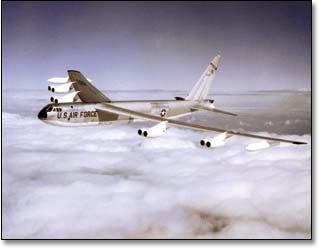 |
| |
|
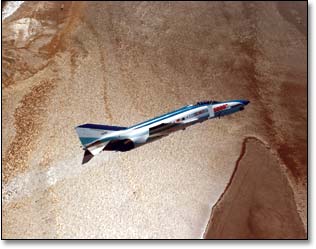 |
F-4 Phantom II
Some aircraft are memorable for the
number produced, length of service or combat record. It is rare
when one is remembered for all three. Such was the McDonnell F-4
Phantom
II. It made its first flight in 1958 and established 16 speed and
altitude records. It was the first supersonic fighter to serve
simultaneously with the U.S. Navy, Marine Corps and Air Force.
The F-4 also served
in the air arms of 11 other nations. It is the only jet ever to
have flown
concurrently with the Air Force's
Thunderbirds and the Navy's
Blue Angels. |
| |
|
Mercury
On May 5, 1961, Alan Shepard became the first American to go
into space. He did so with a suborbit flight aboard a McDonnell
Mercury spacecraft named Freedom 7. Twenty days later, U.S. President
John F. Kennedy made his famous speech calling for the landing
of an American on the moon by the end of the decade. There were
five more Mercury flights, including John Glenn's orbital flight
aboard Friendship 7 in February 1962. Engines developed by the
Rocketdyne division of North American Aviation powered the Redstone
and Atlas rockets used for the Mercury program. |
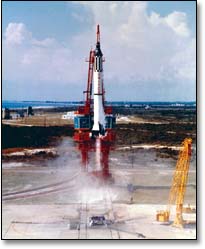
|
| |
|
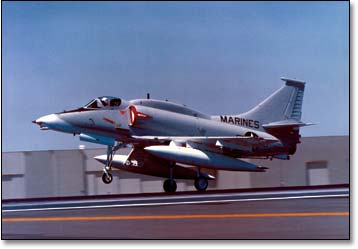
|
A-4 Skyhawk
The Douglas A-4 Skyhawk was America's smallest combat jet. Known
as "Scooter" or the "Mighty Midget," it reversed the trend toward
bigger and more complex aircraft in favor of durability and reliability.
It first flew in 1954, demonstrating combinations of speed and
maneuverability never before seen in a lightweight tactical jet.
The Skyhawk was the most numerous jet built by Douglas. In 1979,
25 years after its first flight, the last of 2,960 A-4s was delivered. |
| |
|
707 Jet Stratoliner
Taking one of the greatest risks in business history, then Boeing
President William Allen gave the go-ahead to invest $13 million
of the company's own money on developing a jet transport prototype.
The Dash 80 was able to win over both the U.S. Air Force and the
airlines, leading to the KC-135 Stratotanker and the world's first
successful commercial jet transport, the 707. Introduced in 1958,
the 707 put Boeing back into the commercial market and led the
way to a family of world-leading jet transports. |
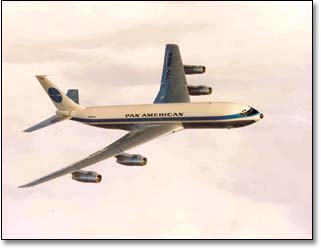
|
| |
|
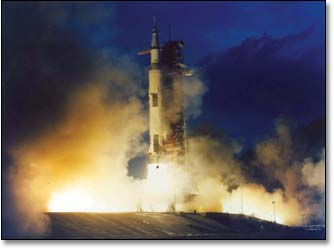
|
Apollo/Saturn
One of the greatest achievements not only in aviation history,
but in human history as well, the Apollo/Saturn program took the
first humans to the moon. Apollo/Saturn was a team effort that
brought together all the major companies that are now part of The
Boeing Company. North American Rockwell built the Apollo command
and service modules, and the second stage of the Saturn booster.
North American's Rocketdyne division was responsible for all of
the Saturn rocket engines. McDonnell Douglas built the third stage
of the Saturn booster, and Boeing built the giant first stage and
the Lunar Rover, and assisted NASA with overall management of the
Apollo-Saturn program. |
| |
|
747 Jumbo Jet
During the late 1960s, some 50,000 Boeing workers took the moniker "The
Incredibles." Their logo was an image of Paul Bunyan because they
knew they were part of something big—the biggest commercial
transport ever to fly and the biggest building in the world, which
would house the manufacture of that plane. As if in defiance of
its critics, the first 747 effortlessly took to the skies on Feb.
9, 1969. Since that time the equivalent of more than half the world's
population have flown on a 747. One of the most popular and successful
airliners of all time, the 747 truly is the "Queen of the Skies." |
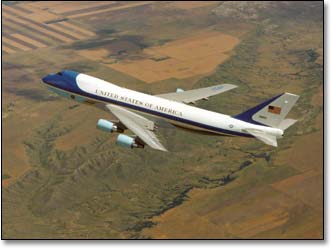
|
| |
|
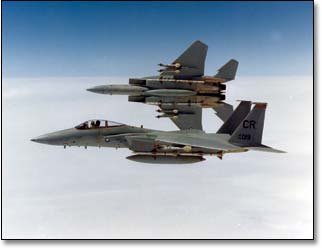
|
F-15 Eagle
The F-15 Eagle has been the most capable air-superiority fighter
in the world for the past 30 years. It has a perfect air-combat
record of 101 victories and zero defeats. With engine thrust greater
than its fully loaded weight, the Eagle can stand on its tail and
climb straight up, accelerating to supersonic speed. It has reached
heights of 98,000 feet (29,700 meters) in less than three and one
half minutes. Today's F-15E Strike Eagle is the world's most capable
multirole fighter and retains the air-to-air capability of the
original F-15. |
| |
|
X-15
The X-15 was designed to conduct research experiments during actual
flight conditions beyond the earth's atmosphere and to obtain knowledge
of aerodynamic heating, re-entry conditions, acceleration and deceleration
forces, and reactions of humans to weightlessness. The X-15 shattered
speed and altitude records. On Aug. 22, 1963, NASA pilot Joseph
Walker piloted the craft to a record altitude of 354,200 feet,
slightly over 67 miles (107 km). U.S. Air Force Capt. William "Pete" Knight
took the X-15A-2 to the fastest speed recorded during the program,
Mach 6.7, during an Oct. 3, 1967, flight. |
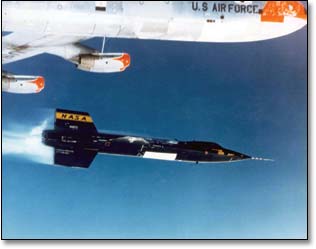
|
| |
|
|

